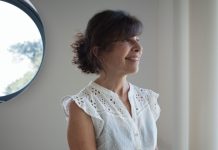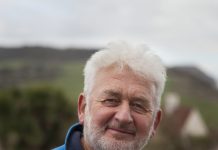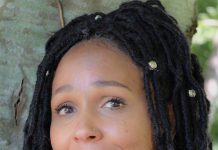‘I grew up at Burrow Hill, near Huish Episcopi, on my family’s cider farm, a carefree and creative early life. My siblings (Alice, Mary and Henry) and I had what people sometimes describe as a feral childhood, but we would all consider idyllic. We were always involved in anything happening on the farm. Aside from helping out with farm jobs we used to cause all sorts of trouble, which seemed to be tolerated as long as it was outside. We would spend hours roaming the moors, and at the farm we would climb on an old building shaped like a pineapple, terrorise each other and the geese, devise booby traps and mud slingers for those working on the farm, and cider customers. At some point there was a concerned mothers’ meeting at the school about us, and even our cousins didn’t come up for a while. This was partly due to a killer pig that roamed the farm and started eating chickens before lambs became prey, and partly because there was always some other relatively innocent trouble to unearth. It was an old fashioned childhood. The goat had to be milked, and we still use a horse and cart to go to the pub in the summer. Then as we got older there were vehicles to crash into hedges and cider to steal. One of the annual family events is Glastonbury Festival where we sell cider from our double decker bus. None of us have ever missed it, and it will always be a highlight for all the extended family. It is a childhood that all of us imagine replicating for our own children, so the older we get the more time we all spend in Somerset. My sister Alice is a clothes designer, Mary has a skin care company, and she has just started growing Lavender and herbs at the farm so she can distil the essential oils. My brother Henry makes films.
I went to Edinburgh University first to study zoology, then to the London School of Tropical Medicine to do my masters in the control of infectious diseases. I also worked for the London School of Tropical Medicine, which took me to Latin America, and East Africa where I worked mainly in malaria economics. At the time I felt that science was a valid career, in a way that perhaps photography wasn’t. I don’t regret that early choice, because it was a good grounding, and I’m now developing a photographic project working with people I knew in those days, in the world of infectious disease control. I think in those early days I wasn’t particularly “into” photography—I always had a camera with me, but I didn’t know about the famous photographers or how influential they were. The passion for it didn’t come until my early twenties. I always thought I’d like to work abroad, and then when you travel and come back you realise how nice Somerset is. For me, lambing in the spring and the autumn harvest are times when I still can’t drag myself away for long. I am spending a couple of days a week working at the farm this autumn because we have had the biggest harvest of my lifetime, so everything is starting early and finishing late. My siblings do the same when they can get away from work. So now it’s about trying to balance the need to travel for work, with living here in Somerset.
I think I always knew I wasn’t going to work in science for ever. I was working in the field in Northern Uganda, on the border with South Sudan where the Lords Resistance Army had had their stronghold. There was a fragile peace at the time, and I was researching the cost-effectiveness of malaria control, which involved a lot of data collection. It was quite a lonely existence, in a one-generator town, and clouds of mosquitos would arrive every evening at 7pm. With evenings very much to myself I really began to learn about my camera. I knew before my last assignment for the malaria consortium that I wanted to make the leap into photography as a career; I just didn’t know quite how.
The only way to turn a passion for photography into something that makes you a living is with total naivety. When I gave up science I certainly didn’t have enough respect for photographers. I just thought that it was a rather nice easy way to tell a faster story—if I was a good writer I’d be a journalist, but I’m not. I thought I might be working along the same routes as I was as a scientist, but using a camera. When I started out as a photographer I thought I could just do it. Actually, everything is learnt in photography, and probably can’t be taught—you have to teach yourself, which of course means that now I consider my early work rubbish. The technical side of it I also taught myself, but if I thought a job was beyond my abilities I’d employ someone who knew more, and learn that way. Having a mentor would have been good because they would have saved me about 5 years of learning by trial and error.
As it turns out, you need to start at the bottom and it’s a long road up to having a market or an audience as a photographer. I’m getting there now, and I’m being pushed into writing a bit more, which I find difficult, but satisfying and something I will continue to pursue. My commercial work is mainly in fashion, and my personal projects are human interest stories, particularly about marginalised societies. In the fashion world it’s really satisfying because you come in with an idea and execute it, and I love the creative possibilities of studio work. In reportage you go and see what’s presented to you, and you learn something every day, which you are there to record and interpret in your own way. If I had to give up one thing it would be the fashion, although reportage is less rewarding financially. Working in both fashion and reportage is an immense privilege.
My first book was published last year, and it was about the flooding here on the Levels in 2012, called Under the Surface, Somerset Floods. It was partly to document the story, and partly to give a voice to the people affected. My second book, Omo – Change in the Valley, has just been published. It’s about the Gibe III dam and its consequences in the Lower Omo Valley in Ethiopia and the Lake Turkana Basin in Kenya. Gibe III began to produce power in October 2015. It has been described as a potential humanitarian disaster for the estimated 500,000 people who live along the Omo River, and around its terminal Lake Turkana. The potential outcomes of the dam have also been likened to one of the world’s worst ecological disasters; the shrinking of the Aral Sea. This is because the agriculture associated with the dam is expected to considerably decrease the river flow and therefore the volume of Kenya’s Lake Turkana, the largest desert lake in the world. The book is captioned by the subjects who talk of the changes and human rights abuses. So in a way both books are about environmental mismanagement, both about water; too much in one case and not enough in the other.
Growing up, we had the luxury of having a mother who would make us clothes and jewellery. She now etches and makes pottery, so the atmosphere at the farm has always been creative and industrious. Seeing our father start the Somerset Cider Brandy Company and create a market for it where there was none, made us all realise that if you have enough passion and determination you can make anything work. My father tried to ban art and push science in his desperation for all of us to have normal jobs—we totally failed him on that. It took about 6 years after I had given up science for him to stop introducing me to people by saying that I was once a scientist. He is resigned to it now and I suspect he realises that what I am doing now makes more interesting tales. My mother comes on the most far flung of my photographic assignments, and is the best travel companion. She often says she would probably be doing the same type of thing if she hadn’t found the farm. As much as you try you don’t fall far from the tree (in this case an apple tree) when you grow up like us.









